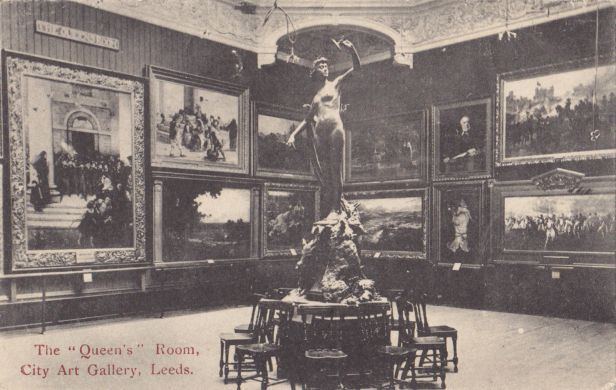Working for Leeds Museums and Galleries over the last year has been a privilege in so many ways, not least the opportunity to witness the transformation of Leeds Art Gallery and the unfolding of its histories. Due to reopen to the public on Friday 13 October, visitors will see the extent to which the galleries benefit from the new roof and its glazed lanterns that illuminate the interiors in ways that, in some cases, have not been seen for over a generation. Much has already been written about the revealed Central Court on the first floor, with its impressive glazed, barrel-vaulted ceiling now visible after around forty years in the dark. In this short blog I would instead like to focus on the subtler but no less important refurbishment of what is now known as the Ziff Gallery (formerly the Queen’s Room) on the ground floor.
The building works created opportunities to revisit the earliest years of Leeds Art Gallery and to think about how we might be informed by the late Victorian architecture and its many subsequent layers. Paint scrapes over the years had never provided conclusive evidence of the original colours of the walls, but a report on the opening of the gallery in the Illustrated London News in October 1888 noted the following scheme: ‘All the new rooms forming the Art Gallery are lighted from the roof, and their walls are coloured in maroon, of dead texture, which shows off the pictures and their gilt frames to the best effect, and which contrasts agreeably with the ivory white of the ceilings and lanterns’. The accompanying wood engravings showed vertically-striped walls and for a long time this was assumed to be either a confection of the illustrator or perhaps a patterned wallpaper. What became clear when work began to strip the walls was that beneath successive layers of paint, wallpapers and cladding, lay the original wooden tongue and groove wall covering, still coloured a maroon that that perhaps darkened over time to an aubergine colour. These boards were found across the galleries and for the first time in living memory, provided a tangible sense of their appearance in their opening years; their purpose to allow pictures to be fixed directly to the walls rather than hung from a picture rail. We decided to take our cue from this original colour scheme in the Ziff Gallery, which will be hung with a selection of works acquired for the collection before 1900, alongside a display of marble and bronze busts depicting the local philanthropists, industrialists and politicians who shaped the cultural life of late Victorian Leeds. We look forward to installing these works from the collections in the coming weeks and sharing them with our visitors in October.
Dr Rebecca Wade, Assistant Curator (Sculpture) and MGHG Website Officer



